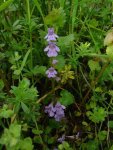Thymus thldrus - clechoma hederacea l.
Family of labial flowers - Lamiaceae (Labiatae)
Botanical characteristics. Perennial herbaceous plant. It grows on wet meadows and fields, in gardens and orchards.
Stem creeping up to 70 cm long, with ascending shoots up to 30 cm tall. Leaves opposite, petiolate, kidney-shaped, covered with absent-mindedly short hairs. Flowers in axillary rings for two or three. Corolla blue-violet. Fruit is an oval-extended brown nut. Blossoms from April to the end of summer.
Spread. It occurs everywhere in the fields, roads, in the kitchen gardens, in the forest, mainly on fertile moist soils.
Used parts of the plant. The medicinal raw material is the whole plant. It is pulled out with a root during flowering and dried at a temperature of no higher than 50 ° C.
Chemical composition. All parts of the plant contain organic acids, essential oil, diterpenoids (marrubin), triterpenoids, steroids, higher fatty acids, iridoids, saponins, alkaloids, vitamins, phenol carboxylic acids (coffee, synapic, ferulic), tannins, flavonoids. Seeds contain fatty oil.
Application. Recently, thymus thighs have been widely used in diseases of the bladder, liver cancer, ascites, bronchopneumonia, diseases of the thyroid and throat, as an antihypertensive drug.
Budry ivy preparations show anti-metastatic, cholagogue, wound-healing properties, have a lactogenic and antibacterial effect. Essential oil is an antiseptic and wound-healing agent, can be used for healing of various wounds, ulcers.
Decoctions and infusions in folk medicine are used for bronchial asthma, bronchitis, pulmonary tuberculosis, stomach, liver, spleen, urolithiasis, various convulsions; Externally - in the treatment of scabies, toothache. In collections - with liver diseases, hemorrhoids, with complicated pregnancy, in obstetrics and gynecology practice as an antiseptic.
Buckthorn ivy is an official raw material in France, Brazil and the United States.
Preparation
- To get the infusion, take 20 g of leaves and flowers, pour 200 ml of boiling water and insist on a boiling water bath for 15 minutes, cool for 45 minutes, filter and take 2 tbsp. Spoons 2-4 times a day, regardless of food intake.
- For decoction, 15 g of the aerial part of the plant or roots is ground, poured into 200 ml of boiling water, insisted on a boiling water bath for 30 minutes, cooled for 15 minutes, filtered. Take 2 tbsp. Spoon 3 times a day after meals.
- For outdoor use, 1 tablespoon of herb is insisted with 1 glass of boiling water or boiled in 1.5 glasses of water for 15 minutes. Cooling, use.
Contraindications. The plant is considered toxic, applied under the supervision of a doctor.




Comments
When commenting on, remember that the content and tone of your message can hurt the feelings of real people, show respect and tolerance to your interlocutors even if you do not share their opinion, your behavior in the conditions of freedom of expression and anonymity provided by the Internet, changes Not only virtual, but also the real world. All comments are hidden from the index, spam is controlled.